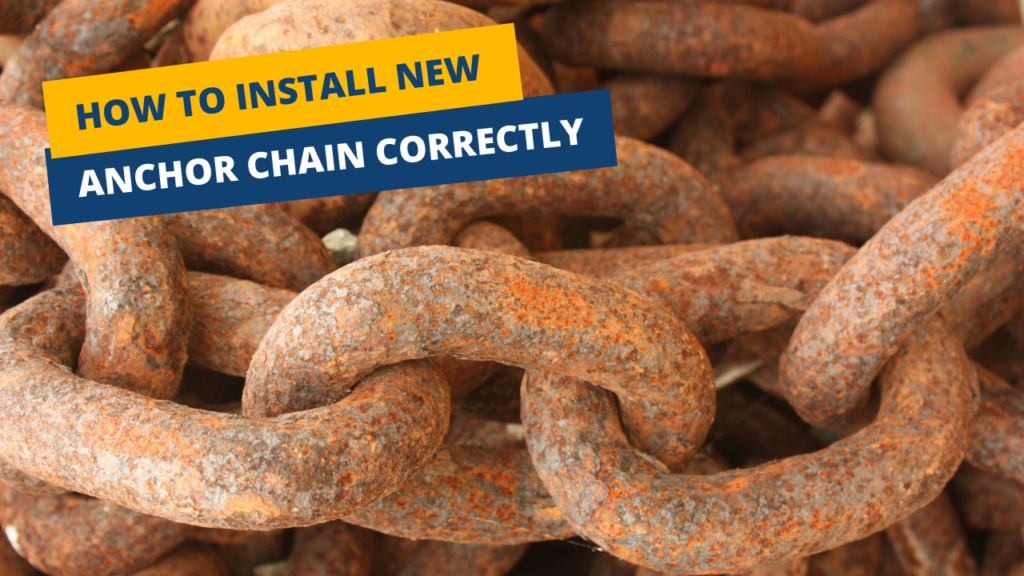Replacing your old anchor chain with a new one isn’t as straightforward as you might think. Use this Checklist to ensure you get the correct chain for your gypsy.
Make sure to purchase our ‘Checklists For Sailors’ guide to get loads more checklists and blueprints for boating success. Check the guide out Checklists For Sailors.

NEW ANCHOR CHAIN CHECKLIST
Take Measurements
- Measure the pitch, which is the internal length between the links. This measurement is essential! A chain that varies by 0.3mm per link can differentiate between working well and not working at all. Measure several links not right next to each other and take the average.
- Measure the width, the area across the shorter side from the outside edges, avoiding the weld.
- Measure the diameter of the wire, which is the size of the actual link. Select a few at random and not next to each other. Measure away from the weld. Depending on the machine that made the link, the weld zone can be bigger or smaller than the wire size.
- Measure eight links at once to compare with eight new chain links.
Get More Information
- Note the numbers on your windlass and call the manufacturer to get a DIN number. That number will help the chandlery, or boat store, located
- Test using sample chain – take a sample piece of chain from the boat store and run it through your gypsy to see if it does, indeed, fit. Alternatively, you can take your gypsy into the chandlery and see if the chain fits.
Replace the Old for New Chain
- Locate a dock, marina, or boat store on the water that will allow you to run your old chain off and put the new chain on. Ask the company selling the chain if they’ll also remove the old chain for you.
- Get the boat in place to make the chain swap.
- Tie a line onto the anchor and have someone pull the anchor to the dock while you let out the chain.
- Remove the anchor and set it to the side.
- Take the new chain out of the barrel and stretch it out so you can measure the chain lengths and mark the links in feet or meters. For example, mark the chain with different-colored inserts every 10 meters.
- Attach the anchor to the new chain.
- Clean out the anchor locker. Give it a new paint job if you have the time.
- Put a line on the other end of the chain and pull it up through the chain plate and to the gypsy.
- Allow enough chain to enter the locker so you can tie it onto the bitter end. The bitter end is a piece of line attached to the hull of the boat that you attach to the chain to keep it from fully falling off the boat.
- Pull all the chain into the locker. Before the anchor comes to the boat, attach a line and have someone hold the line that holds the anchor. This will ensure the anchor doesn’t drop, swing, and hit the boat.
- Lock the anchor in place and smile so that you can tick off another boat job that needs to be done 🙂
Anchor Chain For Boats
These steps apply to galvanized anchor chain, stud link anchor chain, stainless steel anchor chain, and even 5/16″ anchor chain. Any comments, please leave them below.
HI All ! Happy Holidays upcoming ! 12.18.2020
Enjoyed your anchor chain video !
Measure 10 times buy once is my motto !
I use a color code system at each fathom of measure in rivers, blue water,bays
harbors, keep it simple!
Whenever your over the top of questionable sea bed be to use an anchor
retrieval system with a buoy marker! Rode & Anchor are spend y to replace !
Never had to much faith in Windlass’s to much can wear out (unless your
Hercules with a cape) it’s not likely you’ll retrieve that rode back on the vessel !
I’m currently using a drum winch & 500 feet of rode combination , with a horizontal shaft
electric motor & a gas powered engine back up , the deign also use’s a manual lever crank !
It has a pin & friction brake with a good old Samson post back up
May you all be blessed this Christmas & have a pleasant New Years to come ! W.W.